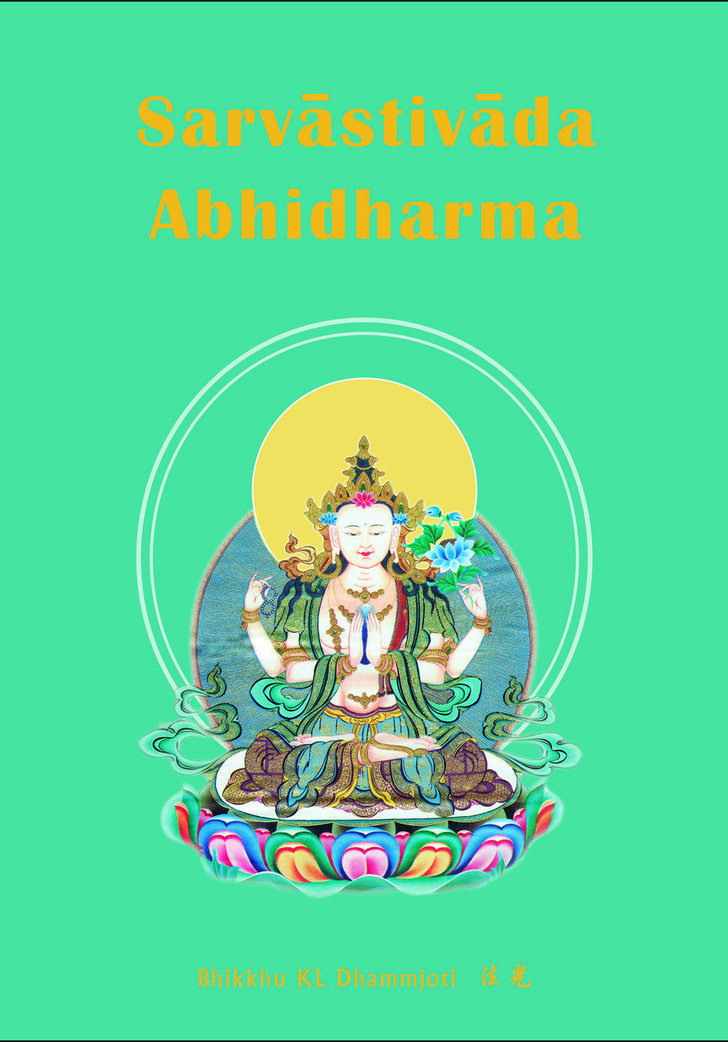Sarvāstivāda Abhidharma (5th Edition)

Sarvāstivāda Abhidharma. 5th Edition. Author: Venerable Professor K.L. Dhammajoti. Hardcover. Published by The Buddha-Dharma Centre of Hong Kong. (Hong Kong, 2015). pp. 640++. ISBN 978-988-99296-5-7
The fourth edition of Sarvāstivāda Abhidharma has been out of print for several years. This new edition makes some revision to a few places in previous edition. This scholarly work presents a comprehensive survey of all the important doctrines of Sarvāstivāda Abhidharma tradition. It is well-documented and utilizes such important references as *Abhidharma-mahāvibhāṣā, Abhidharmakośabhāṣya and *Abhidharma-nyāyānusāra.
CONTENTS
Preface v
Abbreviations xi
Chapter 1 Abhidharma – Its Origin, Meaning and Function 1
1.1. Origin of the abhidharma 1
1.2. Definitions of abhidharma 8
1.3. The soteriological function of the abhidharma 12
Chapter 2 The Ābhidharmika (/Ābhidhārmika) – Standpoint, Scope and Methodology 17
2.1. Fundamental standpoint of the Ābhidharmikas 17
2.2. Arguments for abhidharma being buddha-vacana 19
2.3. Scope of study of the Ābhidharmikas 20
2.4. Ābhidharmika methodology for dharma-pravicaya 28
Chapter 3 The Sarvāstivāda School and Its Notion of the Real 63
3.1. History of the Sarvāstivāda 63
3.2. Sarvāstivāda vs. Vibhajyavāda 67
3.3. Proof of the thesis of sarvāstitva in the VKŚ, MVŚ and AKB 69
3.4. Sautrāntika critique of the epistemological argument 73
3.5. Notion of the real/existent 74
3.6. The various components of the Sarvāstivāda school 84
Chapter 4 The Abhidharma Treatises of the Sarvāstivāda 93
4.1. Seven canonical treatises 93
4.2. Development of the Sarvāstivāda manuals 116
Chapter 5 Sarvāstitva and Temporality 131
5.1. The big debate 131
5.2. Time and temporality 132
5.3. The four main theories of the Sarvāstivāda 133
5.4. Comments on the four theories and Frauwallner’s observations 135
5.5. The Vaibhāṣika theory of kāritra 141
5.6. Saṃghabhadra’s theory — an innovation? 147
5.7. Bhāva, svabhāva and the dharma 150
Chapter 6 Theory of Causality I: The Six Causes 161
6.1. The 6 hetu-s, 4 pratyaya-s and 5 phala-s — their correlation 161
6.2. Special importance of the doctrine of causality for the Sarvāstivāda 164
6.3. Definitions of the six causes 168
6.4. Saṃghabhadra’s defense of simultaneous causation 178
6.5. Explanations in the Yogācāra system 179
6.6. Summary of the notion of the co-existent cause given in the various sources 181
6.7. Doctrinal importance of the co-existent cause for the Sarvāstivāda 182
6.8 Conclusion 186
Chapter 7 Theory of Causality II The Four Conditions and the Five Fruits 191
7.1. Doctrine of the four conditions (pratyaya) 191
7.2. Differences between a cause and a condition 200
7.3. Five fruits (phala) 202
7.4. The ‘grasping’ and ‘giving’ of a fruit 208
Chapter 8 The Category of Matter (rūpa) 213
8.1. General nature and definition of rūpa 213
8.2. Primary and derived matter 219
8.3. ‘Atomic’ theory 226
Chapter 9 The Categories of Thought and Thought-concomitants (citta-caitta) 239
9.1. Definitions of citta, manas and vijñāna 239
9.2. Thought-concomitants (caitta/caitasika) 241
9.3. Development of the theory of caitasika 241
9.4. Sarvāstivāda doctrine of conjunction (saṃprayoga) 254
9.5. Dārṣṭāntika and Sautrāntika Doctrine of successive arising 255
9.6. Difference in functionality between citta and caitta-s 257
9.7. Difference between the first five and the sixth consciousneses 260
9.8. Original nature of thought 262
Chapter 10 Theories of Knowledge 273
10.1. Sarvāstivāda realism: From epistemology to ontology 274
10.2. Various modes of operation of prajñā 279
10.3. Reflexive knowledge and omniscience (sarvajñā) 286
10.4. Prajñā of the Buddha and the two yāna-s 289
10.5. Instrument of perception 295
10.6. Important Sarvāstivāda thought-concomitants involved in discriminative cognition 300
10.7. Ontological status of the objects of knowledge 302
10.8. Direct perception, ākāra, sākāra-vijñānavāda, nirākāra-jñānavāda and the Sarvāstivāda 304
Chapter 11 The Category of the Conditionings Disjoined from Thought
(citta-viprayukta-saṃskāra) 323
11.1. Doctrinal evolution of the category 323
11.2. Definition of conditionings disjoined from thoght in later texts 330
11.3. Classic list in the AKB 331
Chapter 12 Defilements 361
12.1. The goal of spiritual praxis and the abandonment of defilement 362
12.2. Kleśa and anuśaya as the generic terms for defilement 365
12.3. Other doctrinal terms denoting defilements 367
12.4. Defilements as the root of existence 370
12.5. Ābhidharmika investigation of defilements 372
12.6. Classification of defilements 374
12.7. Relationship between defilements and the mind 381
12.8. Operation of the defilements 384
12.9. Abandonment of defilements 388
12.10. Traces (vāsanā) of the defilements and distinction between the wisdom of a Buddha and of an arhat 402
Chapter 13 The Doctrine of Karma 415
13.1. Meaning and general nature of karma 415
13.2. Classification of karma 420
13.3. Informative (vijñapti) and non-informative (avijñapti) karma 421
13.4. Definition and intrinsic nature of informative and non-informative karma 423
13.5. Non-information as restraint, non-restraint and neither-restraint-nor-non-restraint 430
13.6. Paths of karma (karma-patha) 434
13.7. Rationale for the doctrine of non-informative karma 435
13.8. Role of the non-informative in the process of karmic retribution 438
Chapter 14 Karma and the Nature of its Retribution 459
14.1. Karmic retribution as a middle-way doctrine 459
14.2. Six causes affecting the gravity of a karma 459
14.3. Determinate and indeterminate karma 461
14.4. A karma that has been done, and one that has been accumulated 463
14.5. Projecting and completing karma-s 468
14.6. Karma in terms of pratītya-samutpāda 469
14.7. Past karma of the arhat-s and the Buddha 475
14.8. Man’s karma and his environment, and collective karma 477
Chapter 15 The Path of Spiritual Progress 485
15.1. Doctrine of gradual enlightenment 485
15.2. Preliminaries for the preparatory stage 487
15.3. Different stages of the path 493
15.4. Direct comprehension (abhisamaya), path of insight (darśana-mārga) and stream entry (srotāpatti) 509
15.5. Non-retrogressibility of stream-entry 519
15.6. Path of cultivation (bhāvanā-mārga) 519
15.7. Attainment of the four fruits of the spiritual life 521
15.8. Out-of-sequence attainments 522
15.9. Retrogressibility of an arhat 523
Chapter 16 The Unconditioned (asaṃskṛta) Dharma-s 531
16.1. Three unconditioned dharma-s of the Sarvāstivāda 531
16.2. Cessation through deliberation 535
16.3. Cessation independent of deliberation 547
16.4. Space 554
Select Bibliography 565
Glossary 581
Index 621
